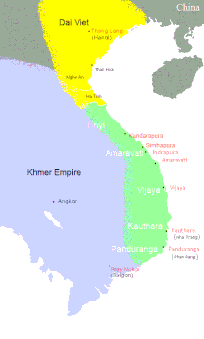Po Binasuor, Ngo-ta Ngo-che, or Zainal Abidin, Cei Bunga ruled Champa from 1360–1390 CE. He was also known as The Red King in Vietnamese stories.
Maha Sawa or Trà Hòa Bố Để was a king of Champa from 1342 to 1360. When his brother-in-law Che Anan died in 1342, Tra Hoa claimed the throne.
Indravarman VI, Ba Dich Lai, Chang-pa-ti-lai, Virabhadravarman, or Ngauk Klaung Vijaya was the son of Jaya Simhavarman V. He took the name Indravarman when crowned in 1432. In order to maintain Đại Việt neutrality, he gave up the important province of Indrapura. Maspero lists Nauk Glaun Vijaya as the son of Jaya Simhavarman V, which may be the same individual, but states he did not assume his father's reign after his death in 1441. Instead, a nephew, Maha Vijaya, ascended the throne.
Rajendravarman II was the king of the Khmer Empire, from 944 to 968.
Ko Cheng, or La Khai, was a king of Champa from 1390–1400. This general of Che Bong Nga's led the retreat back to Champa in 1390, following the death of Che Bong Nga by a musketry salvo. Back in Champa, he declared himself king, usurping the two sons of Che Bong Nga, Che Ma-no Da-nan and Che San-no.
Jaya Ananda or Chế A Nan was made the king of Champa after Che Nang fled. He won Champa's independence against Tran Minh Tong in 1326.
Chế Năng was an Annamese vassal king of Champa. During his reign, he tried to conquer previously lost territories of O and Ly. In 1318, the Vietnamese king, Tran Minh Tong, dispatched generals Tran Quoc Chan and Pham Ngu Lao to defeat Che Nang. Che Nang was defeated and escaped to Java.
Jaya Sinhavarman IV or Chế Chí (制至), son of Chế Mân and first queen Princess Bhaskaradevi, was born in 1284. He reigned as the king of Champa from 1307 - 1312.
Jaya Simhavarman III, Chế Mân (制旻) or Prince Harijit, son of King Indravarman V and Queen Gaurendraksmi, was a king of Champa during a time when the threat of the Mongols was imminent. In 1282, Kublai Khan tried to gain passage through Champa of his ambassadors, but Chế Mân took them prisoner. Kublai Khan then asked Trần dynasty for entrance into Champa but received the same denial. In 1282, Kublai Khan invaded. Indravarman V and Crown Prince Harijit fled into the mountains, forcing the Mongols to suffer heat, illness, lack of supplies and desertion. The death of the top Mongol leader, Sagatou, was the beginning of the end of the Mongol invasion of Champa and Annam.
Indravarman V, Harideva, or Jaya Simhavarman, was a king of Champa whose reign began in 1257 when he assassinated his uncle Jaya Indravarman VI, but waited until 1266 for his coronation. Declining to submit himself in person to the Mongol Khan, Kublai Khan, he nevertheless "subjected himself to this humiliation" of the Mongol commanders Sagatou and Lieu Cheng dividing his kingdom into administrative units. His son, Chế Mân, "could not resign himself."
Jaya Paramesvaravarman II, born Prince Angsaraja of Turai-vijaya, was the king of Champa, following the Khmer voluntary evacuation of Champa in 1220, from 1220 to 1254. In 1252, nonstop territorial growth by Champa caused the Vietnamese emperor Tran Thai Tong to retaliate. In the process, he captured Jaya Paramesvaravarman II's concubine, Bo La Gia, and took other prisoners as well.
Jaya Indravarman VI was the king of Champa from 1254 to 1257. "He was a very peaceful sovereign, given to 'all branches of knowledge and well versed in the philosophies of various schools'." He was assassinated by Indravarman V, his nephew.
Sri Mara was the founder of the kingdom of Champa.
Fan Tat (范逸) also known as Phạm Dat or Fan Yi was the King of Champa, then known as Lin-yi, from 284 to 336. In 284, the King sent the first Cham envoy to the Chinese Emperor's Court. He died in 336, and was succeeded by his commander in chief. Fan came to the throne after a protracted campaign led by his predecessor Fan Hsiung who led attacks on the Chinese province of Jiaozhi.
Fan Wen was the King of Champa from 336 to 349. Fan Wen was the commander in chief to Fan Yi, and, after Fan Yi's death in 336, he seized the throne. In 340, he sent an embassy to China to request the province of Jiaozhi. His request was denied, and so Fan Wen recaptured Rinan in 347. He died two years later on another campaign.
Fan Fo was the king of Champa from 349 to 380, and the son of Fan Wen.
Bhadravarman or Phạm Hồ Đạt was the king of Champa from 380 to 413. In 380, Bhadravarman, the son or grandson of Fan Fo, took the throne with the regal name Dharmamahārāja Śrī Bhadravarman I, "Great King of the Law Bhadravarman".
Fan Yang Mai I or Pham Duong Mai I was briefly the king of Champa, an area populated by the Cham ethnic group in present-day Vietnam. He overthrew the previous dynasty and seized the throne in 420, following years of internal trouble. After an unsuccessful raid in Tongking he requested investiture from China in 421. He died in the same year.
Fan Yang Mai II or Pham Duong Mai II was the King of Champa, an area populated by the Cham ethnic group in present-day Vietnam, from 421 to about 446. In 431, the King was denied the aid of the King of Funan during a war with the Chinese governor of Chiao Chou. In 433, Fan Yang Mai II, after being denied this territory, turned against the Khmers and annexed the Khmer district of Panduranga.
Harshavarman III was a king of Khmer who ruled from 1066 to about 1080 AD. He succeeded his elder brother Udayadityavarman II and his capital was the so-called Second Yasodharapura, which had its center in Baphuon, built by his brother, and West Baray as its principal bàrày.
